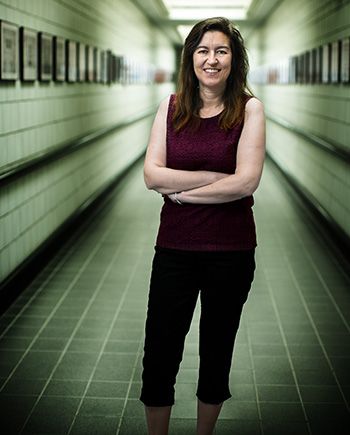The P.A.Th. to better models
The good news for lymphoma patients: Rapid advances in molecular profiling have accelerated our understanding of lymphoma biology, and there has been an explosion in the number of new therapeutic agents. The bad: Scientists need more accurate and rapid laboratory models to be able to harness these advances and translate them into direct benefits to patients.
The large cross-campus collaboration would then use these innovative tools to improve the design of therapeutic regimens and more accurately assign specific patients to treatments that work for them.
“Up to now, almost all pre-clinical work in lymphomas has involved relatively few cell lines grown in 2D culture and mouse xenografts,” said project leader Ari Melnick, M.D., the Gebroe Family Professor of Hematology/Oncology in the Departments of Medicine and Pharmacology. “We are concerned that it will be extremely difficult to effectively harness all of this new knowledge if we do not create more relevant and coordinated experimental therapeutics platforms that better reflect human diseases.”
Melnick said there is an urgent need to accelerate the implementation of new therapies to lymphoma patients, especially those with treatment-resistant (refractory) disease, recurring disease, and the viral lymphomas that often strike elderly and immunocompromised patients.
“Depending on lymphoma subtype, around 40 to 80 percent of patients remain incurable, and ‘cures’ are achieved at the expense of significant short and long-term toxicities,” Melnick said.
In the case of the aggressive diffuse large B-Cell lymphoma (DLBCL), for instance, therapy has changed little in the past 30 years, despite the expenditure of tens of millions of dollars on clinical trials. The disease is so individual to each patient that it is difficult to find biological markers that can sufficiently stratify patients according to risk, or to predict who will be resistant to certain therapies.
“Collectively there are promising leads, but there is still the need to more precisely delineate and classify patients into resistant subtypes based on molecular determinants, and to develop therapies that specifically attack the individual drivers of their disease,” Melnick said.
In addition, many lymphomas require combination of drugs targeting complementary molecular pathways and other complex mechanisms. Proper dosing, sequencing, frequency and combination is critical. The large number of drugs with different pharmacologic properties makes this a daunting prospect. And there have been many examples where the drugs act much differently in Petri dishes than in patients.
“Two-dimensional culture in plastic is not representative of the natural milieu of DLBCL, which lives in a 3-D matrix of different components and the host immune system,” Melnick said. “Plus, there are a relatively limited number of lymphoma cell lines given the tremendous heterogeneity of this disease, and these only partially reflect the genetic and epigenetic background of DLBCL patients.”
To address these challenges, Melnick and colleagues will deploy a completely novel and unique approach to experimental therapeutics focused on the use of improved and alternative model systems: the P.A.Th. (Progressive Assessment of Therapeutics) Program.
They are already working on developing lymphoma organoids grown from patient tumor samples in artificially engineered 3D tissue matrices. Patient tumors will also be “engrafted” into mice to be able to perform sophisticated imaging and therapeutic trials. Other mouse models with lymphoma mutations will allow scientists to study the disease in their native immune and tumor microenvironment. And dogs diagnosed with lymphoma (a common and fatal canine cancer) will get a better chance at a cure, via an innovative “co-clinical trials” initiative that will see them treated in parallel with human patients.
“Progressive selection and refinement of therapies through organoids, followed by mice and then dogs will allow for the most effective and least toxic combinations to be promoted for testing in human clinical trials,” Melnick said.
The program will take advantage of several resources of the Sandra and Edward Meyer Cancer Center, including a comprehensive biobanking program, a computational and biostatistical core, and a cancer therapeutics pharmacy, as well as resources at Cornell University in Ithaca, such as its state-of-the-art animal facilities (including one of the first CRISPR-Cas9 mouse cores) and its top-tier bio- and nano-engineering centers.
It will bring together dozens of researchers and clinicians from both campuses. Other lead investigators include: Giorgio Inghirami, M.D., Kristy Richards, M.D., Ph.D., Leandro Cerchetti, M.D., John Leonard, M.D., Olivier Elemento, M.D., Ethel Cesarman, M.D., Ph.D., Wayne Tan, M.D., Ph.D., and Zhengming Chen, Ph.D, MPH, MS.
The team project also took a team effort to fund – the $5 million was cobbled together from a collection of grants and fundraising from Weill Cornell Medicine, the Meyer Cancer Center, the Leukemia & Lymphoma Society (LLS), private donors such as Ian and Isabelle Loring, and even the Laborers International Union of North America, which contributed a generous $1 million from its members.
It was part of $40.3 million invested by LLS to fund a diverse array of research to find better treatments and cures for patients with leukemia, lymphoma, myeloma and other blood cancers.
“LLS is leading the way by investing in cutting-edge research and clinical trials with the most promise of yielding cures and improving survival and the quality of life for blood cancer patients,” said Louis J. DeGennaro, Ph.D., LLS President and CEO. “In our 67-year history, we have invested more than $1 billion in research to advance breakthrough therapies and cures, and many of our successes in the blood cancers are now helping patients with other cancers and chronic diseases.”




